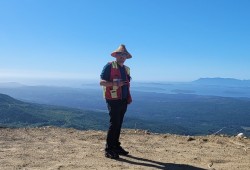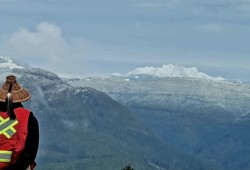The provincial government recently announced an investment of $8.9 million, over a period of three years, for First Nations and the province to partner in the establishment of a guardianship training initiative.
“It supports, officially and importantly, things that have been going on in nations forever,” said Nathan Cullen, minister of Water, Lands, and Resources, in an interview with Ha-Shilth-Sa. “That is: having people out on the land and the water, observing, monitoring, protecting [and] enforcing - depending on which nation we're talking about.”
Cullen explains that this funding opportunity answers what nations in British Columbia had been asking for: providing training opportunities and broadening the role for guardians.
The training will be designed “for the nation and by the nation” explains Cullen, and it will occur on their respective territories.
“This is going to happen within [their] territories and in a way that is culturally appropriate to the nations who are running the program,” said Cullen.
For Harry Brossault of Huu-ay-aht First Nation, he spends five days a week monitoring and protecting his ha’houlthee, as well as that of neighbouring nations, as a Wit Wak guardian for C̕awak ʔqin Forestry.
“The benefits of the funding, it's also not going to just help the nation or industry, it's also going to help the community,” said Brossault.
He explains that it benefits the community because of the knowledge that Wit Wak guardians have about where to find devil’s club, yarrow, and when to harvest cedar bark, among others.
The Wit Wak guardians operate throughout TFL 44 defined forest area, which encompasses the territory of nations such as Huu-ay-aht, Ditidaht, Pacheedaht, Uchucklesaht, Hupacasath and Tseshaht, among others, said Brossault. Wit Wak guardians monitor these areas and ensure that the investments that nations are making in forestry are protected, he continued.
“It's an honor to be able to assist another nation and I think it goes back to the way things were before where Huu-ay-aht helps Tseshaht and vice versa, and it gets people back out onto the land,” said Brossault. “[We are] doing our best to ensure that our Ha’houlthee is being taken care of.”
Brossault shares that as a Wit Wak guardian, when he is driving through Nuu-chah-nulth territories in TFL 44 he helps drivers if they have broken down vehicles or need directions. He watches for people poaching firewood and monitors garbage from campers.
When Brossault notices a hazard on the roads he notifies his manager to get a crew in the area, and places signs for drivers to navigate safely.
He has also assisted with checking on big trees that are to be protected within the Ha’houlthee. With hazardous trees that have been taken down, he and his team have delivered firewood to elders.
Brossault said the knowledge of his Ha’houlthee that he’s gained from working as a Wit Wak guardian has benefitted him and those around him. He volunteers for the warrior youth group and has been able to bring youngsters out to their Ha’houlthee to harvest traditional medicine.
“I think it's going to benefit many nations that can access funding for [it],” said Brossault of the new training program. “I get to drive up mountains, and possibly stand where some of my ancestors have stood before. I get to help take care of my territory and my neighboring territories as well.”
Duane Nookemis, councilor for Huu-ay-aht First Nation, said the guardian programs are enforced so that Huu-ay-aht are aware of what happens in their Ha’houlthee. He explained some of these considerations were climate change, campers, fire bans, and protestors.
“I thought it was good for us to have some eyes out there to keep track of what's going on, and document and to inform people of where they are, and what is expected of them as they camp or visit our area,” said Nookemis.
“I think [guardians] have a lot of responsibility when [they’re] out there. Not too many non-natives know the history of what they're traveling through or whose territory they're in [and] what spots are culturally significant to us and are important to us,” said Nookemis. “A lot of them don't even know what the regulations are. So having a voice out there, explaining these things, and telling them where they are, I think is really important for us as a nation… It gives us a better idea of what's going on and what we can do in the future to improve things.”
Cullen explains that guardianship programs are developed depending on the needs of the nation. The roles of guardians are broad; some guardians take the role of compliance and enforcement, similar to a conversation officer or DFO official, while others participate in observation, monitoring, and collecting data within their Ha-houlthee, he continued.
“We make those agreements together between ourselves and the nation to get the guardian program right,” said Cullen.
He explains that in order to restore land, enact conservation efforts, and bring back biodiversity, “having people out on the land and water is essential for that success.”
“Incorporating traditional knowledge into the decisions that get made, having that constant presence on the water and on the land is invaluable,” said Cullen.
Additionally, Cullen said that having people on the ground to be the “eyes and ears” can help improve land and resource practices as well as ensure the agreements and decisions that have been made are implemented.
“I think [funding] brings the opportunity for… the First Nation perspective on what's going on in our territories. I mean, the federal government [and] provincial governments - you don't see them around [and] down in our remote areas that much patrolling or looking, keeping an eye on things,” said Nookemis.
“I think that's the big part of the program, is keeping an eye on these sacred places and [culturally] significant places,” he continued. “Where you find your medicine and your plants, and all your other stuff that you use for medicine and traditional art.”



